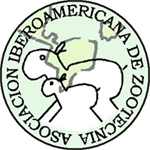Archivos de Zootecnia es una revista científica internacional de periodicidad trimestral, fundada en 1952 por el Instituto de Zootecnia de la Facultad de Veterinaria de Córdoba y editada por la Universidad de Córdoba y la Asociación Iberoamericana de Zootecnia. Incluye trabajos inéditos redactados en español, inglés o portugués cuya finalidad es difundir los resultados de la investigación en Producción Animal y áreas afines, con especial atención a los sistemas ganaderos de las zonas desfavorecidas y en vías de desarrollo, sus razas locales y las producciones animales alternativas.
Archivos de Zootecnia publica artículos, notas breves, revisiones bibliográficas y cartas al editor que son sometidos a un estricto proceso de evaluación.
 |  |  |  |
Dr. Diego Jordano Barea Fundador y Director Honorario de Archivos de Zootecnia Catedrático de Biología Botánica y Zoología Aplicada | Dr. Gustavo Gómez Castro Director Honorario de Archivos de Zootecnia pa1gocag@uco.es | Dr. José Javier Rodríguez Alcaide Presidente Honorario del Consejo Editorial de Archivos de Zootecnia Cátedra PRASA de Empresa Familiar. Universidad de Córdoba | Doña Carmen López de Bustamante Secretaria de Redacción Honoraria de Archivos de Zootecnia cs9bucoc@uco.es |
Avisos
Tasas de procesado, edición y publicación |
|
Estimados autores, el consejo editorial de Archivos de Zootecnia informa que los autores de los trabajos enviados a Archivos de Zootecnia a partir del 01/09/2018 deberán satisfacer la tasa de publicación establecida que se describe en el presente anuncio y en la Guía para autores. En la actualidad todos los costes de publicación de la revista Archivos de Zootecnia son sufragados por la Universidad de Córdoba, y más concretamente desde su Grupo de Investigación PAIDI-AGR-218. Lo limitado de los presupuestos nos está impidiendo un desarrollo pleno de la revista, que concluye con su definitiva evaluación positiva del JCR y por tanto la obtención de un Índice de Impacto importante. Para ello nos proponemos mejorar los servicios que ofrece la revista en términos de acortar los tiempos de evaluación y publicación, mejorar la calidad de los artículos e incrementar a seis el número de volúmenes publicadas al año, aparte de posibles volúmenes que pudieran surgir. Estamos recibiendo un número de 600 artículos sometidos al año y por ello necesitamos un refuerzo de personal de gestión para conseguir avanzar en los objetivos planteados, y precisamos reforzar el cuerpo de editores sectoriales y de revisores, por todo ello hemos decidido corresponsabilizar a los usuarios de la revista, con dos modificaciones en nuestras normas de funcionamiento, que entrarán en vigor a partir del día primero de septiembre de 2018. Estas medidas son: 1. Se incorporará una tasa para sufragar los gastos de procesado, edición y publicación de la revista. 2. Se pedirá a los autores que publiquen en Archivos de Zootecnia su disponibilidad para actuar como revisores de la revista, ofreciéndoles como beneficios a los que actúen como tales a una deducción del 25% en las tasas y un trato prioritario de sus sumisiones. 1.- Tasas de procesado, edición y publicación Las tasas de la publicación de Archivos de Zootecnia son 300€ para los artículos y revisiones y 180€ para las notas brevesque serán facturados y deberán ser abonados en el momento de la aceptación. La capacidad de los autores para pagar los honorarios de la publicación nunca será una consideración en la decisión final de publicación. Estas tasas serán revisadas anualmente. Otras formas de pago podrán ser a través de Western Unión o transferencia bancaria a la cuenta siguiente: En todos los casos la revista deberá percibir las cantidades concertadas, quedando los costes de transferencia por parte de los autores. Las tasas de publicación (también denominadas "cargos por procesamiento de artículos" o CPAs) ayudan a Archivos de Zootecnia a recuperar los costos de publicación, incluyendo la administración de revisiones por pares, la producción de revistas y el alojamiento y archivado en línea. Archivos de Zootecnia publica todo el contenido de acceso abierto y hace que el contenido esté disponible en línea libremente para que los investigadores y los lectores lean, distribuyan y reutilicen. La capacidad de los autores para pagar los honorarios de la publicación nunca será una consideración en la decisión final de publicación. Archivos de Zootecnia sólo cobra una cuota por artículo y envía una factura en el momento de aceptación del artículo. Los autores no reciben cargos adicionales basados en el color, la extensión, las figuras u otros elementos. Las cuotas de publicación están sujetas a cambios. Los CPAs aplicados serán aquellos que estén vigentes en la fecha de envío del artículo. Archivos de Zootecnia tiene términos específicos y cargos de publicación para artículos que forman parte de números especiales específicos según cada caso. Reducciones en la tasa de publicación Todos los editores sectoriales activos recibirán un descuento del 50% (90€ para notas breves y 150€ para artículos y revisones bibliográficas) en las tasas en todos los artículos que figuren como autores o coautores. Los revisores activos de la revista tendrán un descuento del 25% (135€ para notas breves y 225€ para artículos y revisones bibliográficas) en las tasas de publicación del primer artículo que publiquen con posterioridad a su actuación. Sólo se considerarán en este apartado las revisiones de calidad y el descuento podrá cubrir distintas revisiones de forma aditiva. Es decir, diversas revisiones dan derecho a deducciones en artículos diferentes, nunca se acumularán sobre el mismo artículo. Contacto ¿Preguntas sobre facturación o pago? Póngase en contacto con la oficina de pagos en. Correo electrónico: animalbreedingconsulting@gmail.com Teléfono: +34 957218706 |
|
| Publicado: 2018-09-13 | Más... |
Admisión de Idiomas |
|
| ADMISIÓN DE IDIOMAS | |
| Publicado: 2017-08-04 | Más... |
MIGRACIÓN DE ARCHIVOS EN PROCESO |
|
Desde Septiembre de 2016, la antigua web de Archivos de Zootecnia está siendo migrada al completo a esta nueva plataforma. Asimismo, se están procesando todos los números de la revista de manera retrospectiva hasta el primer número y estarán a la disposición de los usuarios de manera progresiva. Mientras tanto, para consultar los pasados números no dude en acceder a:
|
|
| Publicado: 2017-03-23 | Más... |
| Más avisos... |
AÑO 2023 VOL. 73 NUM. 281
Tabla de contenidos
Artículos
|
F.J. Navas González, J.V. Delgado Bermejo
|
1-5
|
|
N.L. Ribeiro, G.R. Medeiros, J.H.S. Costa, S.G.C.G. Santos, G.V. Nascimento
|
6-16
|
|
H. Bonilla-Remache, D. Guevara-Freire, P. Toalombo-Vargas, J.V. Delgado, F.J. Navas, D. Avilés-Esquivel
|
18-22
|
|
J.M. Alanzor Puente, Á.L. Pons Barro, A. González Ariza, C. Marín Navas, I. Concepción Felipe, J.V. Delgado Bermejo, F.J. Navas González
|
24-27
|
|
J.M. Alanzor Puente, Á.L. Pons Barro, A. González Ariza, C. Marín Navas, I. Concepción Felipe, J.V. Delgado Bermejo, F.J. Navas González
|
28-31
|
Notas Breves
|
C.J. Cuéllar, J. Hincapié, P.J. Ross, R. Castillo
|
32-37
|
|
K. Schimitti, F. Moreira, A.L. Barth, R. Palmeira, V. Peripolli, I. Bianchi, J. Santos, L. Fernandes, E. Schwegler, M. Ziegler
|
38-41
|



.jpg)





